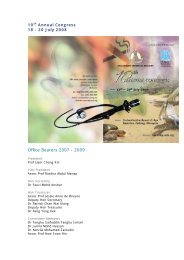download - Malaysian Thoracic Society
download - Malaysian Thoracic Society
download - Malaysian Thoracic Society
Create successful ePaper yourself
Turn your PDF publications into a flip-book with our unique Google optimized e-Paper software.
Annual Congress of <strong>Malaysian</strong> <strong>Thoracic</strong> <strong>Society</strong><br />
Symposium 5A<br />
Mycobacterium<br />
Endobronchial Tuberculosis – the Hidden Entity<br />
Abdul Razak Muttalif<br />
Malaysia<br />
Endobronchial tuberculosis (EBTB) is defined as tuberculous infection of the tracheobronchial tree.<br />
The reported incidence of EBTB has been as high as 10% to 20% in patients with the active parenchymal<br />
disease. More than 90% of patients with EBTB have some degree of bronchial stenosis resulting from cicatricial<br />
healing of mucosal ulceration or necrosis. The peak incidence occurred in the second decades, with 3.8 times<br />
higher incidence noted in female than in male subjects.<br />
Common symptoms are cough, haemoptysis, sputum production, wheezing, chest pain and fever in active<br />
disease and dyspnoea and wheezing in the fibrous stage. This form of tuberculosis is difficult to diagnose<br />
because the lesion is not evident in the chest radiograph, frequently delaying treatment. Computerized<br />
tomography is very useful in evaluating bronchial lesions such as stenosis or obstruction.<br />
The most important goal of treatment in active EBTB, is the eradication of tubercle bacilli. The second most<br />
important goal is prevention of bronchial stenosis. In inactive disease, treatment to restore full patency is<br />
appropriate. Corticosteroid therapy for prevention of bronchial stenosis remains controversial, but the best<br />
results are associated with minimal delay in the initiation of steroid treatment. Aerosol therapy with streptomycin<br />
and corticosteroids is useful in treatment against active EBTB. Time to healing of ulcerous lesions is shorter,<br />
and bronchial stenosis is less severe in patients on aerosol therapy. Progression to bronchial stenosis may be<br />
prevented if the therapy is initiated as soon as possible.<br />
As steroids or other medication are unable to reverse stenosis from fibrous disease, airway patency must<br />
be restored mechanically by surgery or endobronchial intervention. Tracheobronchial stenting produces<br />
symptomatic improvement but multiple revisions is expected, at times up to 10 times. Tracheobronchial<br />
tear poses daunting clinical challenges. Surgical treatment may offer better outcome in some cases. The<br />
modes of surgical treatment in EBTB includes: sleeve resection, lobectomy, pneumonectomy and bronchial<br />
reconstruction.<br />
41








